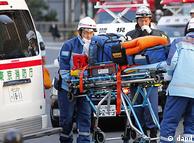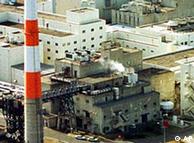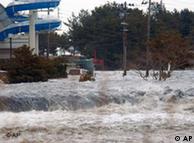NATURAL DISASTERS | 11.03.2011
Japanese PM declares nuclear power emergency situation
Japanese Prime Minister Naoto Kan declared a nuclear power emergency situation on Friday – this usually occurs if there is confirmation of radioactivity leaks from a nuclear power plant or a reactor cooling system breaks down but this did not initially seem to be the case.
"We have declared a nuclear emergency state to take every possible precaution," Chief Cabinet Secretary Yukio Edano said. "Let me repeat that there is no radiation leak, nor will there be a leak," he told a press conference.
 Fire brigades have to be especially effective when putting out a blaze at a power plantThe International Atomic Energy Agency said that the four nuclear power plants closest to the epicenter of the earthquake had been safely shut down. The Vienna-based watchdog immediately liaised with the Japanese authorities to confirm further details and also started monitoring which other countries and nuclear facilities could be at risk from the tsunami that the quake unleashed.
Fire brigades have to be especially effective when putting out a blaze at a power plantThe International Atomic Energy Agency said that the four nuclear power plants closest to the epicenter of the earthquake had been safely shut down. The Vienna-based watchdog immediately liaised with the Japanese authorities to confirm further details and also started monitoring which other countries and nuclear facilities could be at risk from the tsunami that the quake unleashed.Later, a heightened state of alert was declared at the Fukushima Daiichi nuclear power plant, where there were conflicting reports on whether the cooling tower was functioning or not.
Two thousand residents in the surrounding area were told to evacuate their homes.
"If you shut down a reactor there is still a lot of heat in the fuel and this requires several hours of active cooling," Greenpeace expert Jan Beranek told Deutsche Welle. "You need lots of water to take the heat out of the reactor. This is the critical moment because if you do not manage the flow of water the residual heat in the reactor’s fuel can be big enough to cause melting and potentially damage the reactor."
Potential release of radiation
Generally, he added, Japan’s reactors are built in such a way as to withstand earthquakes and to shut down automatically. However, there are other issues which have to be observed with regard to tsunamis.
"If a flood comes close to a nuclear power plant, it can have an impact on the reactor’s cooling system. Even if the reactor is undamaged, there can be a problem managing it and this can eventually lead to a meltdown and release of radiation," he explained.
 There are 55 operating nuclear power plants in JapanHe also explained that a blaze at Tohoku Electric Power Company's Onagawa nuclear plant in could potentially be a problem depending on where it was occurring and how long it would take the fire brigade to extinguish it.
There are 55 operating nuclear power plants in JapanHe also explained that a blaze at Tohoku Electric Power Company's Onagawa nuclear plant in could potentially be a problem depending on where it was occurring and how long it would take the fire brigade to extinguish it.He said that it was logical that the fire had broken out in the turbine hall "because there is a lot of oil that is combustible. It is not close to the reactor itself so there is no immediate risk but it could spread and that could be a problem."
Later media reports said that the fire had been extinguished but that experts were keeping a very close eye on all plants in the vicinity of the earthquake.
There are currently 55 operating nuclear power plants in Japan. Two more are under construction and about a dozen are in the advanced planning stages.
Author: Anne Thomas
Editor: Thomas Bärthlein
Editor: Thomas Bärthlein


1 comment:
η γη μας τρέμει προκαλώντας θανάτους και καταστροφές, η θάλασσα φουσκώνει συμπαρασύροντας ανθρώπους και χαλάσματα και ο πανεπιστήμων ανθρωπος με τα πυρηνικά του σπέρνει την καταστροφή στην φύση και σε καθε ζωή, φυσική και φυτική. Αναρωτηθήκαμε που πάμε?
Post a Comment